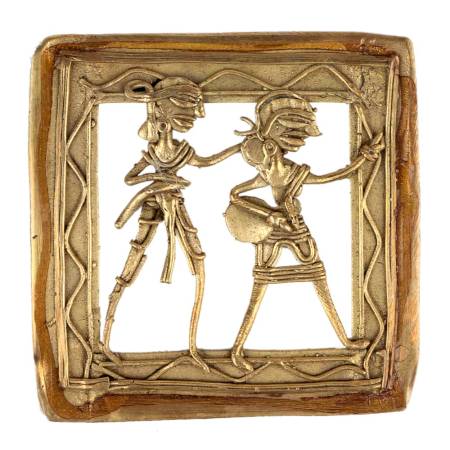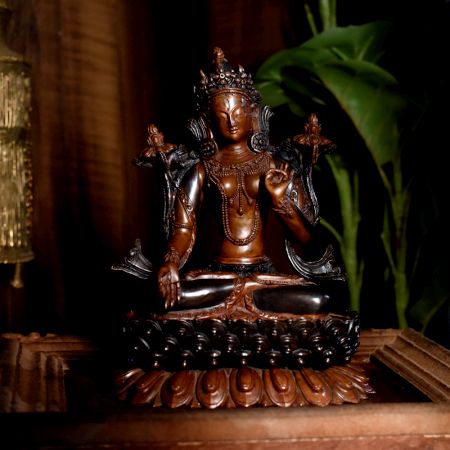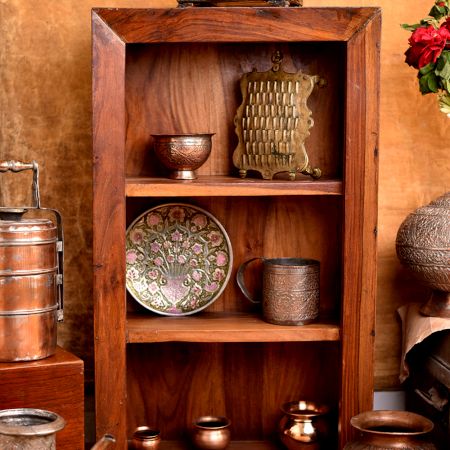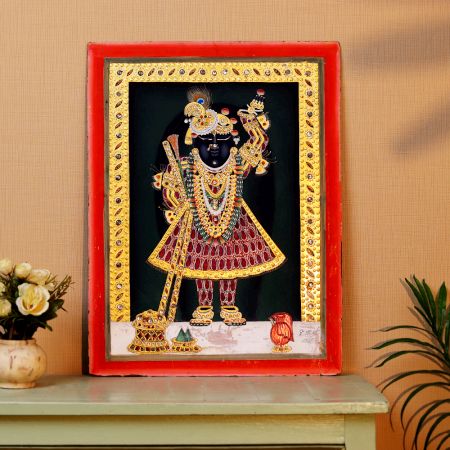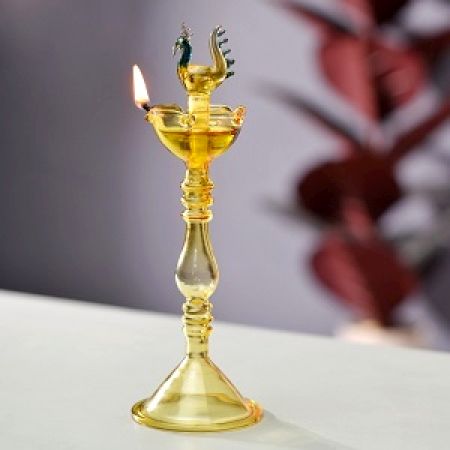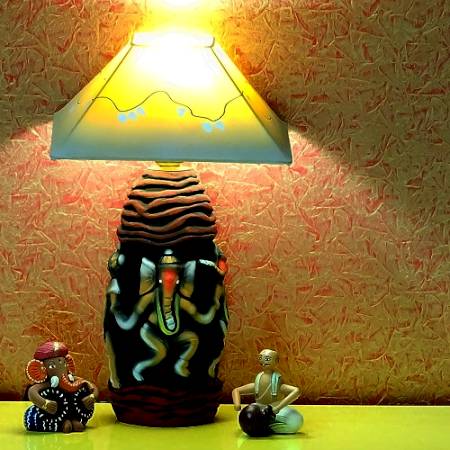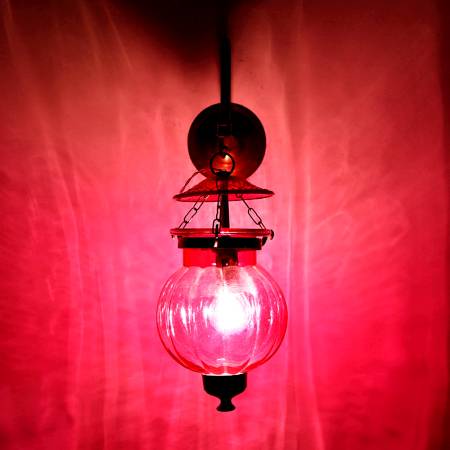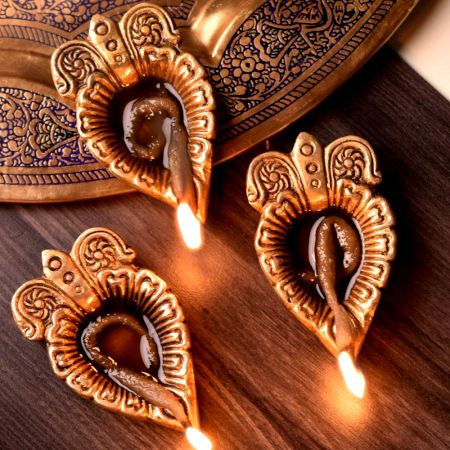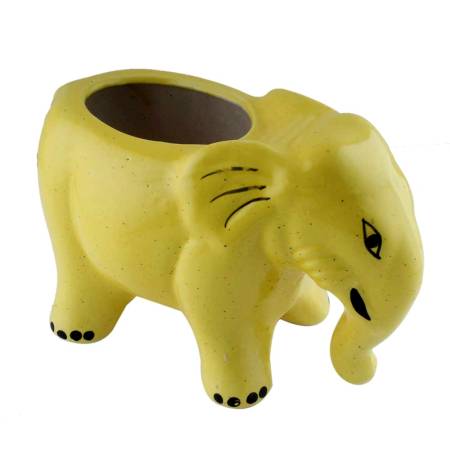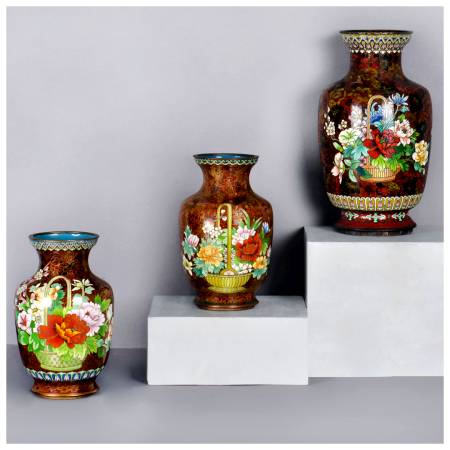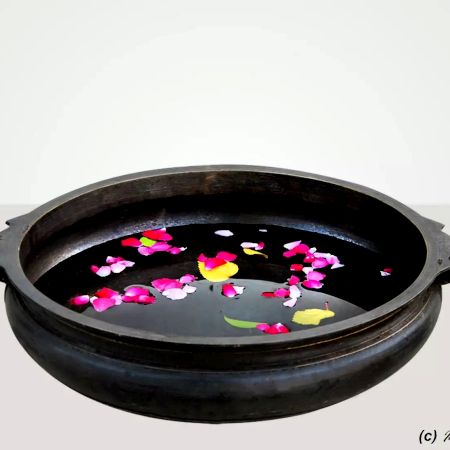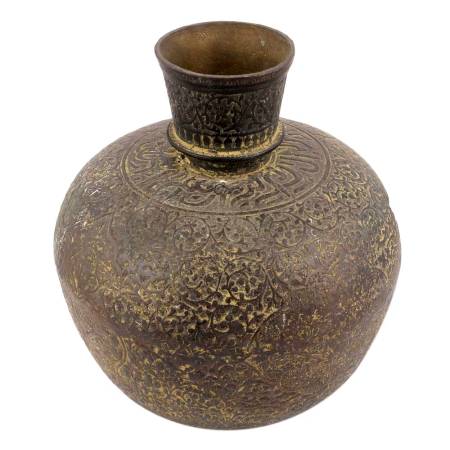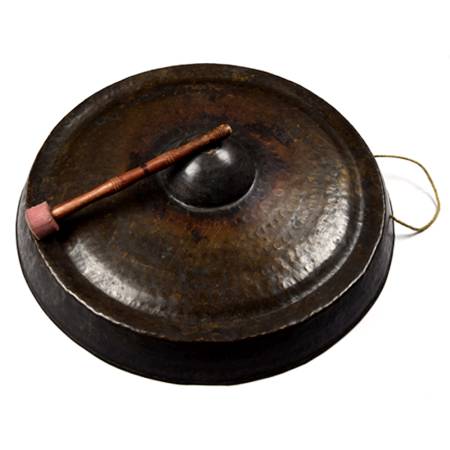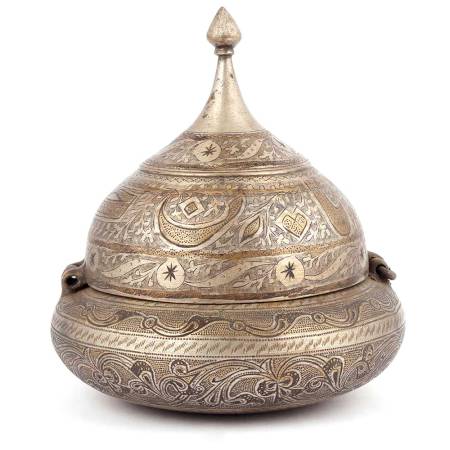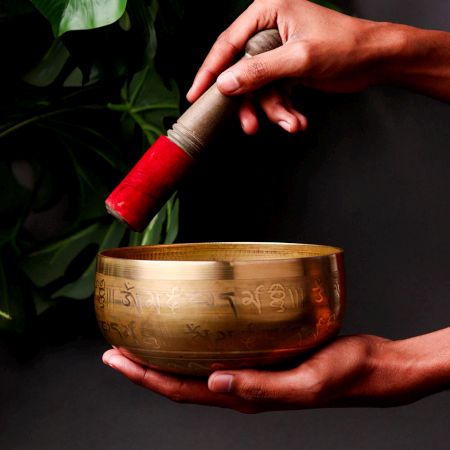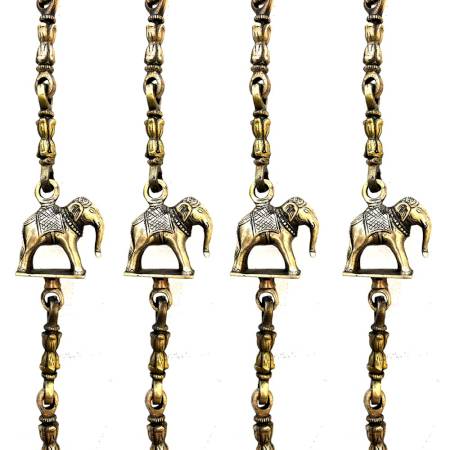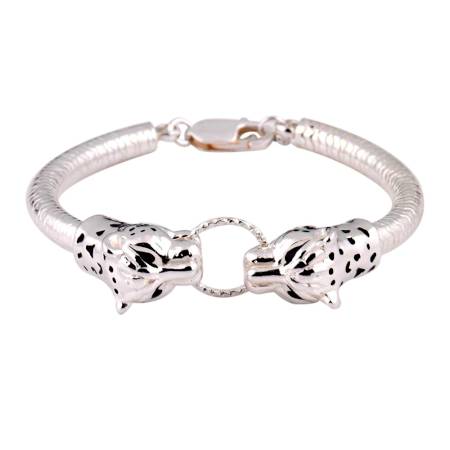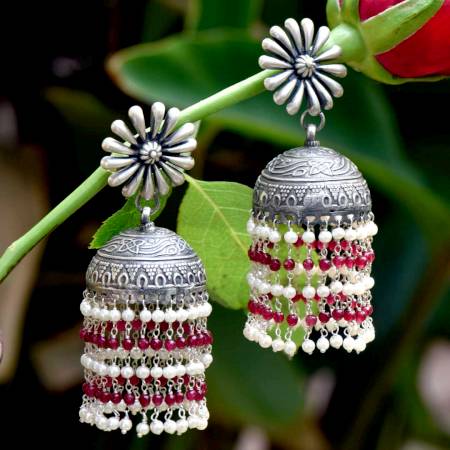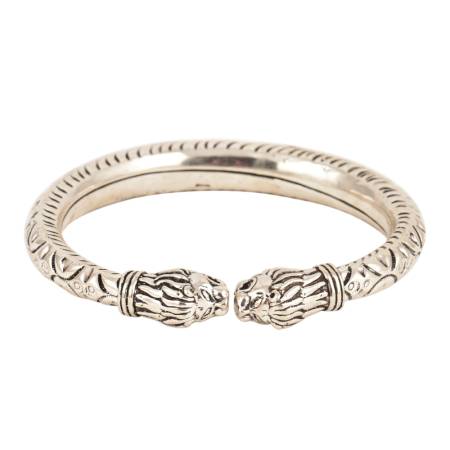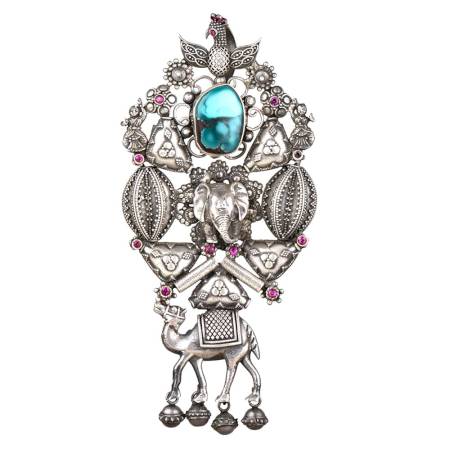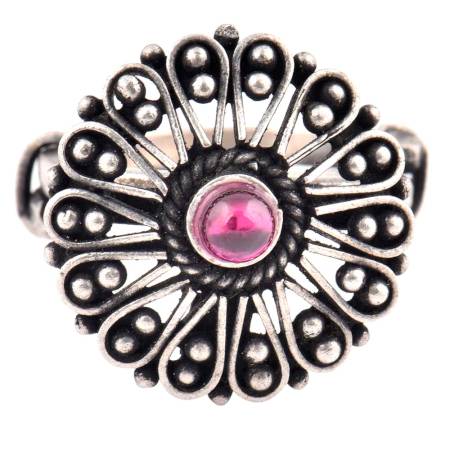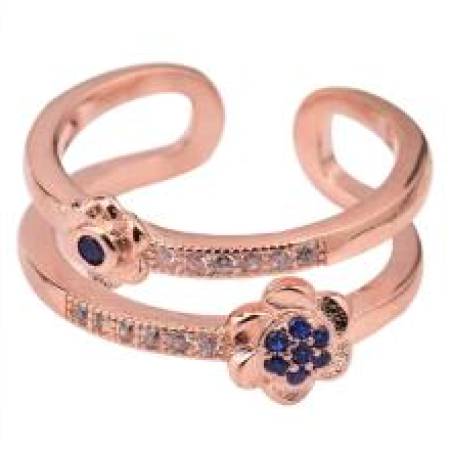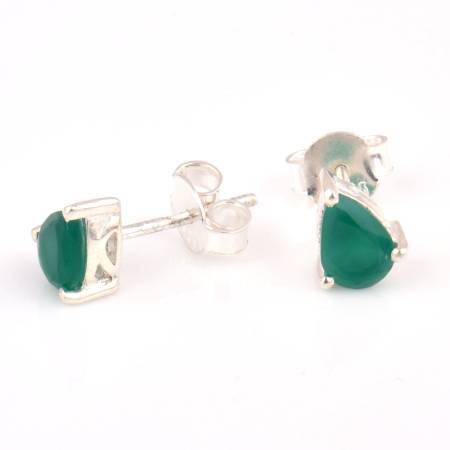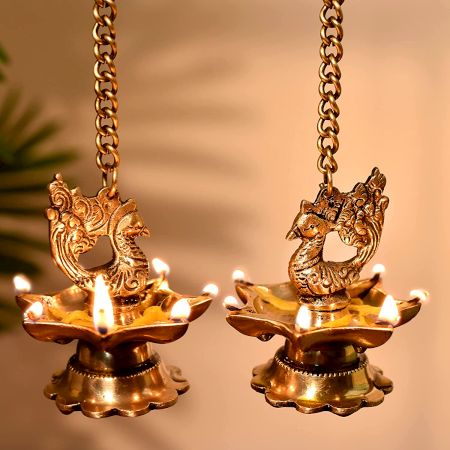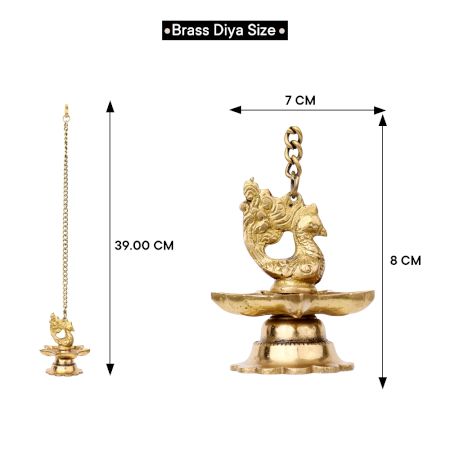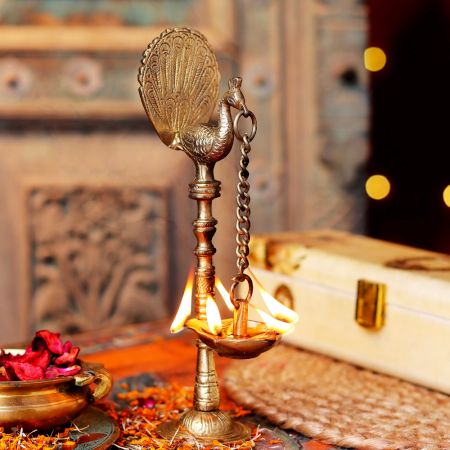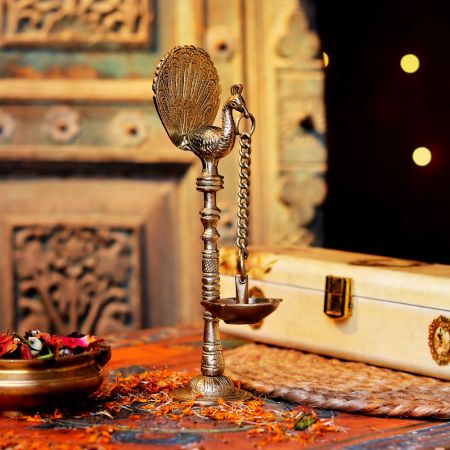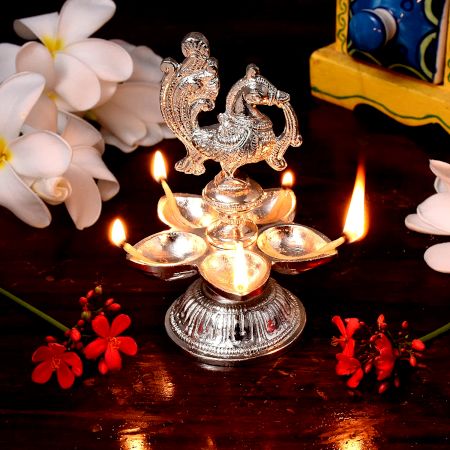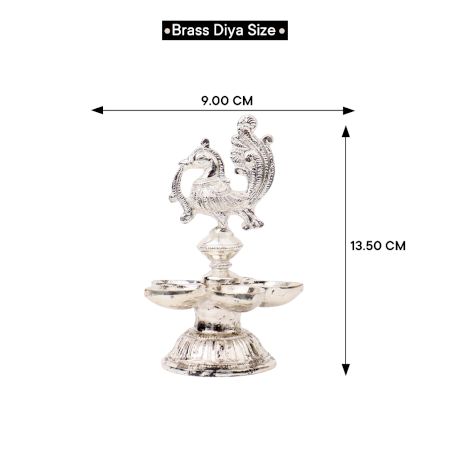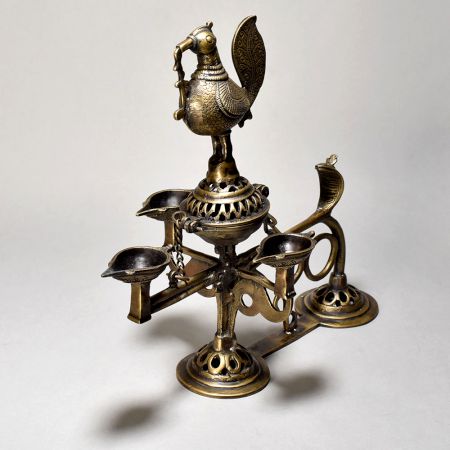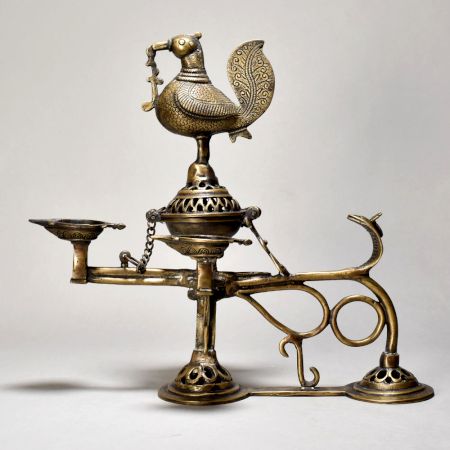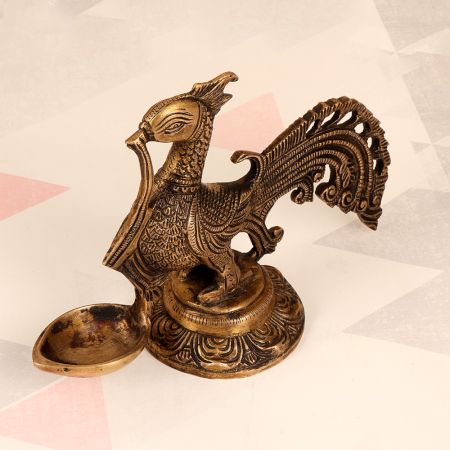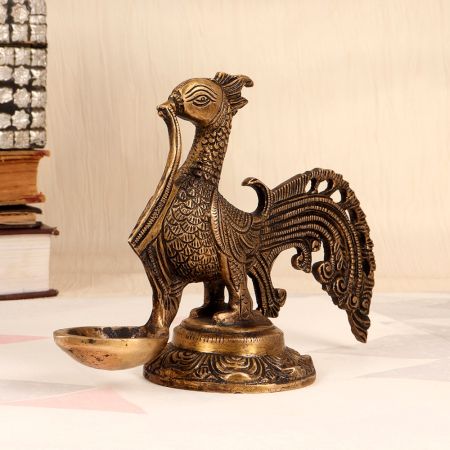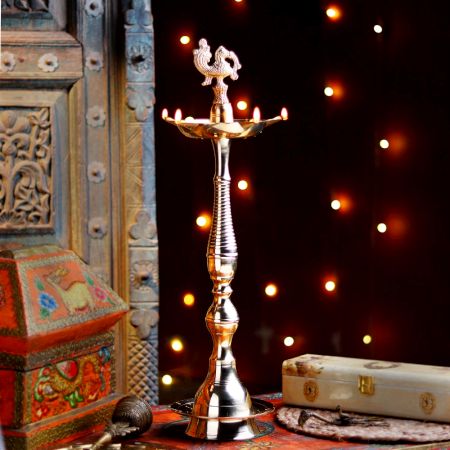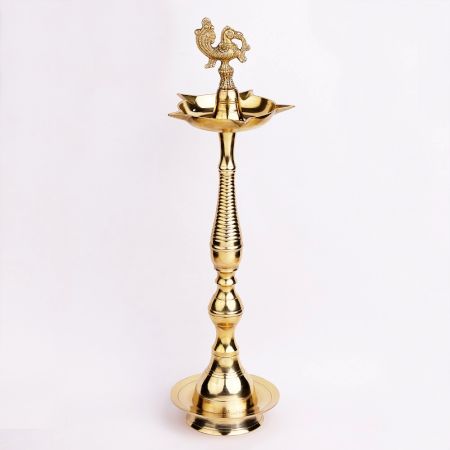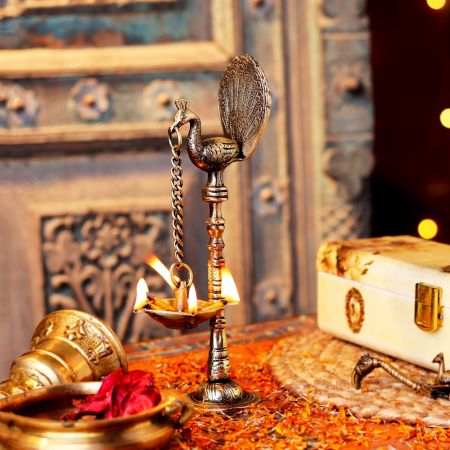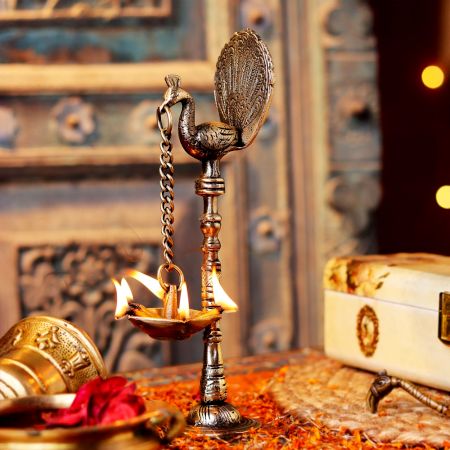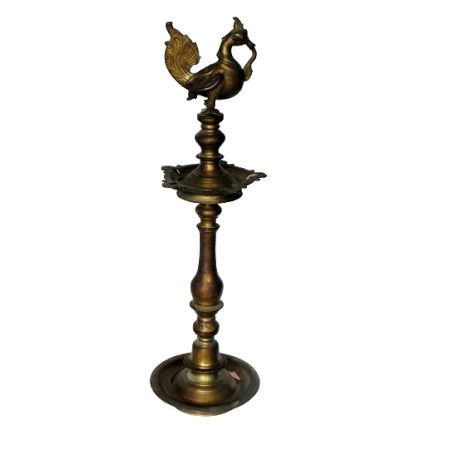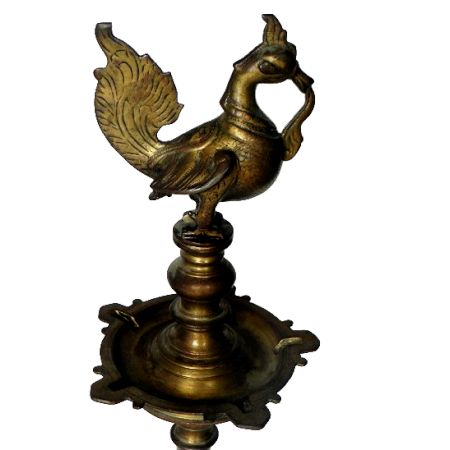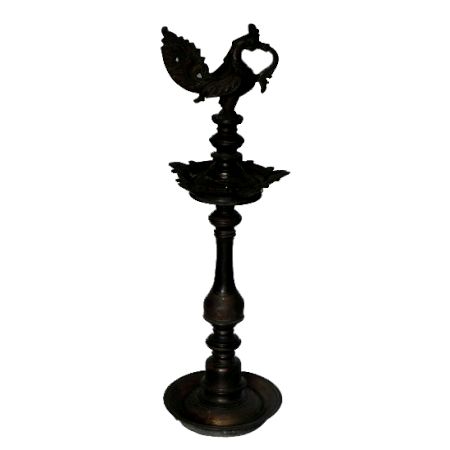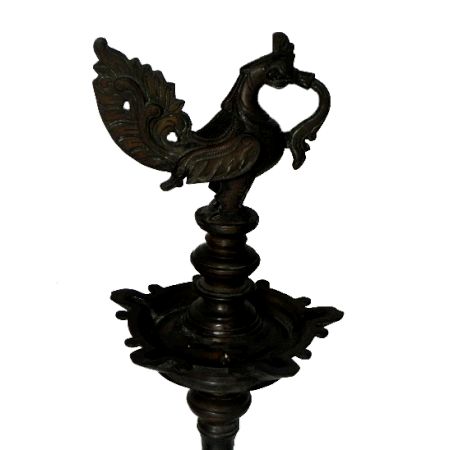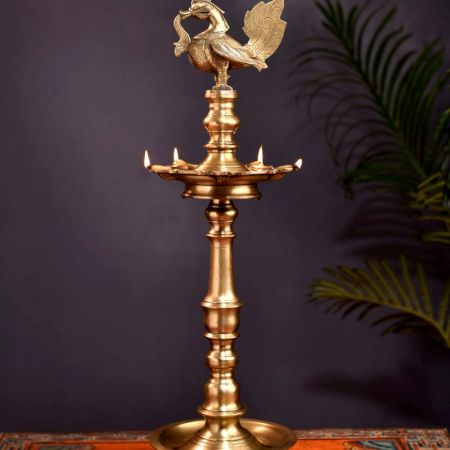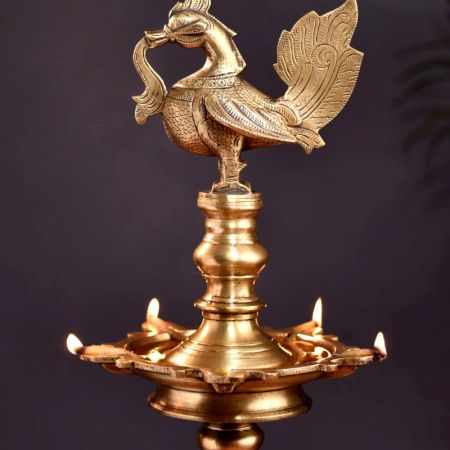-
Brass Peacock Figurine Oil Lamp Diya With a Silver Polish For Diwali
-
₹ 1,377.50
₹ 1,450.00 -
Only a few left
-
₹ 1,377.50
-
Exquisite Brass Peacock Many Diyas Hanging Bells Dancers Figurine
-
₹ 15,485.00
₹ 16,300.00 -
Only 1 left
-
₹ 15,485.00
-
Brass Oil Lamp With Laxmi Ganesha And Twin Peacocks Statue Festive Diya
-
₹ 1,567.50
₹ 1,650.00 -
Only 1 left
-
₹ 1,567.50
A Guide to Mayur South Indian Oil Lamps and Their Symbolic Importance
The Mayur South Indian oil lamp is not just an object of light but a vessel of stories, layered in cultural resonance. Its very name “Mayur” draws from the peacock, a symbol of grace, beauty, and divine connection in Indian heritage. These lamps are steeped in centuries of tradition, often linked to temple rituals, festive ceremonies, and auspicious beginnings. They merge symbolic imagery with functional purpose, embodying the rhythm of faith and artistry. Whether placed in a sacred space or a modern home, they carry the quiet strength of cultural memory while inviting a sense of warmth and reverence.
What Is A Mayur South Indian Oil Lamp?
A Mayur South Indian oil lamp is a traditional lamp designed with peacock-inspired motifs, used primarily in rituals, ceremonies, and festive occasions across South India. The peacock’s form, often stylized into the lamp’s stem or crown, signifies beauty, wisdom, and auspiciousness. These lamps are typically crafted in metal, most often brass or bronze, and are structured to hold oil and wicks that can burn steadily for hours. Beyond illumination, they act as spiritual conduits, believed to invite prosperity and ward off negativity. Their design is both practical and symbolic, blending art, devotion, and utility. Even when adapted for contemporary décor, the essence remains, light as a bridge between the physical and the divine, a tradition that continues unbroken from temple courtyards to modern living rooms.
What Emotions Or Themes Do Mayur Oil Lamps Commonly Portray?
Mayur oil lamps often evoke themes of purity, celebration, and divine connection. The peacock element suggests pride, grace, and renewal, while the warm glow of oil-fed flames conveys serenity and hope. In traditional use, lighting such a lamp marked an intentional act, a moment of stillness before prayer, a beginning that demanded reverence. The themes stretch beyond religion as they represent the continuity of tradition, the endurance of beauty, and the idea that light can conquer darkness. In festivals, they carry joy, in solemn rituals, they carry peace. Their form, often detailed and symmetrical, communicates balance, a reminder that harmony between the material and spiritual worlds is not only possible but necessary. Even in contemporary spaces, they subtly invite reflection on heritage, artistry, and the shared human need for warmth and illumination.
What Are The Most Recognized Designs In Mayur Oil Lamps (e.g., Traditional, Ornamental, Temple-Style)?
Mayur oil lamps present three widely recognized design families. Traditional designs keep the lamp simple yet symbolic, focusing on a peacock figure integrated into a functional, tiered lamp structure. Ornamental designs expand the detailing with floral engravings, intricate tail feathers, and sculptural bases that elevate them into decorative art pieces. Temple-style lamps stand taller, heavier, and more elaborate, often with multiple tiers and large reservoirs for oil to sustain long ceremonial hours. These designs differ in complexity but share the peacock motif as a central element. The choice of design often depends on context as homes lean toward manageable sizes with artistic detailing, while temples opt for grandeur and endurance. Each style carries the same symbolic weight but adapts in scale, structure, and decorative richness to match its setting, whether intimate or monumental.
Why Are Mayur Oil Lamps Still Revered In The Contemporary Decor World?
Their relevance today stems from their ability to fuse cultural authenticity with aesthetic versatility. In an age where décor often leans toward the minimalist or industrial, Mayur oil lamps bring a grounded, handcrafted presence. They are heritage pieces that adapt, fitting into eclectic interiors, heritage-themed spaces, or even sleek modern homes that crave a single statement of tradition. Their symbolic meanings, prosperity, light, and renewal, are timeless, making them more than decorative artifacts. Collectors and designers appreciate their craftsmanship, the play of light they offer, and their ability to anchor a space in cultural narrative. In gifting, they carry blessing, in décor, they carry identity. This blend of beauty, symbolism, and adaptability keeps them alive in both emotional and design-driven contexts, ensuring that they remain more than relics as they are living traditions.
Craftsmanship, Materials & Artistic Detailing of Mayur Oil Lamps
The creation of a Mayur South Indian oil lamp is a slow, deliberate art form, where every curve, weight, and motif is intentional. Traditionally, master artisans followed techniques passed down through generations, often within the same family or guild. Craftsmanship went beyond visual appeal as balance was vital, ensuring the lamp could stand firmly while holding oil without spillage. The peacock form was sculpted to flow naturally with the lamp’s structure, not simply attached as ornamentation. This integration of form and function reflects the deep respect artisans held for the lamp’s symbolic and practical roles, making each piece both devotional and durable.
How Were Mayur Oil Lamps Traditionally Crafted?
The process began with selecting and purifying the chosen metal, often brass or bronze, as these were believed to hold auspicious properties. Artisans worked with wax models or clay molds to define the lamp’s basic form, which was then cast using the lost-wax method. After casting, the lamp underwent detailed chiseling, engraving, and polishing. The peacock was not a separate attachment but an integral sculptural element designed to balance weight and symbolism. Proportions were meticulously considered so that the lamp remained steady when lit. Inscriptions or motifs could be added depending on the patron’s request. The final step was a ritual blessing before the lamp was ready for use, underscoring its role as more than a utilitarian object as it was a bridge between artistry and spirituality, designed to last across generations.
What Materials Were Commonly Used In Traditional Mayur Oil Lamps (e.g., Brass, Bronze, Copper)?
The preferred metals were brass and bronze due to their durability, workability, and warm reflective qualities that amplified the flame’s glow. Brass, an alloy of copper and zinc, offered a golden hue and resistance to tarnish, making it suitable for daily use. Bronze, with its copper-tin composition, brought deeper tones and heavier weight, ideal for ceremonial or temple lamps. Copper itself was sometimes used, though less frequently, as it required more maintenance to prevent corrosion. These metals also carried cultural significance, believed to attract positive energy and withstand ritual use without degrading. Their tactile qualities allowed artisans to engrave fine details in the peacock’s feathers or the base patterns. Beyond function, the choice of metal influenced the lamp’s emotional presence, brass for vibrancy and brightness, bronze for gravitas and permanence, copper for warmth and intimacy.
What Role Do Size, Weight, And Structure Play In Lamp Design?
Size, weight, and structure are foundational to both function and symbolism. Smaller, lighter lamps are designed for household use, easy to move, and intimate in presence. Larger, heavier temple lamps ensure stability during long rituals and signify grandeur. Weight distribution affects safety, a well-balanced base prevents tipping, especially when oil and multiple wicks are lit. Structure dictates how the peacock motif integrates, in taller lamps, it crowns the top tier, in smaller ones, it merges with the stem. The proportions also influence flame behavior, wider bowls allow broader light spread, while taller stems elevate the flame for ceremonial prominence. Every dimensional choice shapes how the lamp performs, how it feels to hold, and how it occupies space. A well-crafted Mayur oil lamp is not just seen, it is felt, in its presence, balance, and the confidence it inspires when lit.
Symbolism and Cultural Storytelling of Mayur Oil Lamps
Mayur oil lamps are more than decorative objects; they are vessels of cultural memory and spiritual resonance. Rooted in South Indian traditions, the peacock motif symbolizes beauty, wisdom, and divine protection. These lamps often appear during festivals, weddings, and sacred ceremonies, acting as both a source of light and a storyteller of heritage. The curves, motifs, and placement of the peacock are deliberate, weaving mythological references with blessings of prosperity. Through them, households silently converse with their ancestors, deities, and traditions, reminding us that illumination is not just about dispelling darkness, but about nurturing continuity between the past and present.
What Stories Or Messages Do Mayur Oil Lamps Aim To Convey?
Mayur oil lamps often narrate stories drawn from mythology and folklore. The peacock, associated with Kartikeya in Hindu tradition, embodies valor, purity, and spiritual awakening. Its spread wings carved into the lamp reflect the victory of light over ignorance. Many lamps subtly convey seasonal cycles, fertility, and cosmic balance, inviting harmony into the home. When lit, the flame becomes a living storyteller, casting shadows that resemble wings in motion, symbolizing life’s constant renewal. These designs are intentional, crafted to remind the beholder of virtues like patience, grace, and inner strength. The very act of lighting them is a symbolic dialogue between human devotion and divine energy, a reminder that every ritual, however small, is a continuation of an ancient narrative still breathing in our homes.
How Do Craftsmen Express Spiritual, Cultural, Or Auspicious Symbols Through Lamp Designs?
Craftsmen embed cultural and spiritual meaning through careful selection of form, posture, and engraving. The peacock is sculpted with regal poise, sometimes holding a floral vine or a bell in its beak, each element bearing a specific blessing. Lotus bases evoke purity and spiritual growth, while intricate borders mirror temple architecture, creating a bridge between home and sacred space. Many artisans subtly integrate astrological symbols or local floral patterns to reflect regional identity. The crafting process itself is ceremonial, metal warmed, shaped, and polished with a reverence akin to prayer. Every curve is not merely artistic, it is coded with blessings for prosperity, protection, and continuity of tradition, making each lamp both a visual and spiritual heirloom.
How Do Light, Shape, And Motifs Influence The Aura Of A Mayur Oil Lamp?
The aura of a Mayur oil lamp emerges from the interplay between flame, form, and symbolism. A tall, slender design projects elegance, while a broader base lends stability, each shaping the mood of the space. The peacock’s curves direct light upward, creating a halo effect, enhancing the sense of divinity. Motifs like the lotus or paisley enrich this aura with layers of meaning, purity, abundance, renewal. As the flame flickers, these shapes cast intricate shadows on walls, turning a room into a quiet theatre of tradition. This immersive experience transforms lighting into an act of spiritual grounding, where beauty and belief coalesce.
Purchase, Collection & Investment of Mayur Oil Lamps
Buying a Mayur oil lamp is not merely a transaction, it is the adoption of a cultural artifact. Whether antique or newly crafted, each lamp carries an echo of artistry and heritage. Collectors often seek pieces with authentic regional designs, intricate detailing, and historical value. Reproduction lamps, while affordable, can still hold meaning if crafted by skilled artisans. The market spans temple auctions, trusted handicraft emporiums, and curated online platforms. A true collector’s joy lies in finding a piece whose history resonates personally, where the peacock’s gaze and the lamp’s weight feel like holding a fragment of a living tradition in your hands.
Where Can You Buy Authentic Or Reproduction Mayur Oil Lamps?
Authentic Mayur oil lamps are best sourced from specialized craft markets in South India, heritage exhibitions, and government-recognized handicraft emporiums. Cities like Chennai, Thanjavur, and Kumbakonam are renowned for skilled metal artisans whose families have been crafting these lamps for generations. Temple auctions occasionally offer historical pieces with documented provenance. For those unable to travel, reputable online platforms like IndianShelf that work directly with artisans, rather than mass producers, can provide high-quality reproductions. The key is to choose sellers who provide detailed descriptions of origin, crafting technique, and materials used. Whether you seek a ceremonial piece or a decorative addition, the buying process should feel like a cultural exchange, not just a purchase.
How Can You Verify The Authenticity Of A Traditional Mayur Oil Lamp?
Verifying authenticity involves examining both craftsmanship and provenance. Authentic lamps often have slight, deliberate imperfections, marks of handcrafting rather than machine precision. The metal should feel solid and well-balanced, often made of brass or bronze with a natural patina that develops over decades. Engravings should be deep, with motifs that are culturally accurate and proportionally harmonious. Provenance documents, artisan stamps, or temple records can provide historical backing. In absence of documentation, consulting local experts or museum curators familiar with South Indian metalwork can help. Ultimately, authenticity is confirmed when the lamp reflects both artistic integrity and cultural accuracy, preserving the lineage of its tradition.
What Makes A Mayur Oil Lamp A Worthwhile Decorative Investment?
A Mayur oil lamp’s worth lies in its blend of cultural depth, artistic skill, and timeless appeal. Unlike trend-based decor, these lamps age with grace, gaining character as their patina deepens. For collectors, antique pieces with known origin and exceptional craftsmanship can appreciate in financial value. For households, even contemporary versions bring an enduring sense of heritage to interiors, serving as both functional light sources and conversation pieces. Their symbolic richness ensures they remain relevant across generations. Investing in one is less about owning an object and more about preserving an unbroken cultural dialogue, ensuring that each flame lit continues a story older than memory.
Care, Polishing & Preservation of Mayur Oil Lamps
Mayur Oil Lamps, with their poised peacock motifs and luminous brass sheen, are more than functional objects, they are living artifacts of cultural memory. Their care is an act of respect, a quiet dialogue between hands and heritage. Over time, brass interacts with air, oils, and the residue of flames, shaping a patina that can either be nurtured or renewed. Polishing and preservation demand balance: too much shine and the history is erased; too little care and the design fades into neglect. Maintaining them is both a craft and a ritual, blending patience, skill, and reverence.
How Do You Properly Store And Maintain A Mayur Oil Lamp?
Storing a Mayur Oil Lamp is less about space and more about environment. Choose a dry, dust free location away from direct sunlight, as brass responds quickly to humidity and temperature shifts. Before storing, ensure the lamp is fully cleaned, oil residues attract dust and encourage tarnish. Wrap the lamp in a soft, breathable cotton cloth to prevent scratches. If in long term storage, check periodically to prevent moisture buildup. Maintenance involves gentle cleaning with mild soap and water, followed by thorough drying. A light coat of natural oil, like coconut oil, acts as a protective layer without compromising its finish.
What Finishes And Polishes Best Complement The Traditional Aesthetic?
For a Mayur Oil Lamp, the best polishes are those that preserve the brass’s natural warmth rather than overly brightening it. A soft, matte glow suits its traditional form, achieved with lemon and salt rubs or tamarind paste, both natural and non abrasive. Commercial brass polishes can be used sparingly, but ensure they’re free from harsh chemicals that strip texture. After polishing, a micro wax or natural beeswax finish helps maintain the tone while providing gentle protection. The aim is not to create a mirror shine but to evoke a lived in radiance, echoing the lamp’s heritage while respecting its age and design.
Can Old Oil Lamps Be Restored Without Losing Their Original Charm?
Yes, restoration is possible without erasing history if approached carefully. Begin by removing surface dirt with a soft brush and mild soapy water, avoiding hard scrubbing that could erase fine details. Tarnish can be reduced with natural acidic agents, but leave traces of patina for character. For structural repairs, like fixing loose joints or dented bases, use traditional metalworking techniques rather than modern adhesives. Restoration should enhance usability without modernizing the piece. The key is restraint, leave signs of age that tell its story. Over polishing or re casting parts risks turning heritage into imitation.
What Are Common Damages Mayur Oil Lamps Suffer Over Time?
Common damages stem from both use and neglect. Continuous lighting can leave soot deposits, while uncleaned oil residue corrodes surfaces. Brass is prone to oxidation, leading to greenish verdigris if left in damp conditions. Delicate peacock feathers and engravings may flatten from over polishing. Mishandling can bend stems or misalign the oil cup. Older lamps may suffer from loose joints, especially where the base meets the stem. Preventing these issues means combining mindful usage with regular upkeep, ensuring the lamp remains a glowing presence rather than a fragile relic.
Home Decor, Styling & Ambience Setting With Mayur Oil Lamps
A Mayur Oil Lamp is more than an object, it is a silent anchor in a room’s atmosphere. When lit, it does not merely provide light, it changes the rhythm of a space. The flame softens edges, deepens shadows, and invites stillness, making it ideal for moments of reflection or celebration. Even unlit, its presence commands attention, offering a bridge between the ornate past and the curated present. Whether placed in a pooja room, a hallway corner, or the heart of a living room, it tells visitors something unspoken about values, traditions, and the owner’s sense of aesthetic depth.
How Can Mayur Oil Lamps Influence A Room’s Ambience Or Tone?
A lit Mayur Oil Lamp introduces warmth that transcends mere illumination, it creates a glow that feels alive. The shifting light dances on nearby surfaces, lending movement to still spaces. In a formal living room, it softens formality, in a pooja space, it deepens spiritual resonance. Even when unlit, the peacock design and brass tones lend a regal, grounded presence. Depending on placement, it can draw the eye upward, invite quiet conversation, or set a meditative mood. The lamp’s influence lies in its ability to be both a visual statement and a subtle mood setter.
What Interior Styles Pair Well With Traditional Brass Lamps?
Mayur Oil Lamps naturally harmonize with Indian traditional interiors, rich wood furniture, earthy textiles, and carved details. Yet, they also adapt well to eclectic or bohemian spaces where cultural artifacts are celebrated. In minimalistic or modern homes, the lamp becomes a striking contrast, a point of historical texture in a clean lined setting. Pair it with warm lighting, soft fabrics, and neutral backdrops to let the brass stand out. In colonial or heritage inspired spaces, it integrates seamlessly, looking as if it has always belonged. The key is balance, allow the lamp to be noticed without crowding it with competing elements.
How Do You Choose The Right Mayur Oil Lamp For A Living Room, Hallway, Or Pooja Space?
For a living room, choose a medium to large lamp that commands presence without overpowering furniture. Opt for intricate detailing that can be appreciated up close. In hallways, slender or tall designs work best, drawing the eye along the passage and creating a visual pause. For pooja spaces, smaller or traditionally proportioned lamps work well, focusing on functionality and ritual aesthetics. Consider scale, design complexity, and the space’s existing colors. Always ensure the lamp’s style complements the overall mood, ornate for celebratory spaces, simpler forms for serene corners. The right lamp feels as if it was destined for that spot.
Cultural Impact & Historical Legacy of Mayur Oil Lamps
The Mayur oil lamp, crowned with a peacock motif, is more than a vessel for light, it is a bearer of stories, rituals, and layered meanings. Across centuries, it has illuminated temples, homes, and community gatherings, becoming a quiet witness to evolving traditions. Its presence in households often marks an unbroken chain of heritage, where craftsmanship is entwined with devotion. Each curve, feather, and contour holds the cultural imprints of South India’s artistic lineages. The lamp’s survival in the modern age isn’t accidental, it thrives because it bridges the old with the new, carrying the poetry of continuity while adapting to shifting tastes.
What Is The Historical Significance Of Mayur Oil Lamps Across Regions?
The Mayur oil lamp’s historical significance lies in its ability to unify symbolic artistry with functional purpose. In Tamil Nadu, it has been linked to temple ceremonies, representing divine presence through its peacock, a sacred bird associated with Lord Murugan. In Kerala, variations of the lamp found a place in Onam festivities, with the flame symbolizing abundance and welcome. Andhra Pradesh and Karnataka incorporated the design into wedding rituals, where the lighting of the lamp was both a blessing and a promise. These regional variations didn’t dilute its meaning, they enriched it. The lamp evolved into a cross-cultural artefact, adapting motifs to reflect local legends while maintaining its identity. Its enduring appeal lies in this flexibility, where it serves as both an emblem of shared cultural memory and a marker of regional pride. Over time, its story became inseparable from the spiritual and social fabric of South Indian life.
How Did Different South Indian Traditions Contribute To The Evolution Of Lamp Designs?
South Indian traditions shaped Mayur oil lamps by layering them with region specific symbolism and structural variations. Tamil artisans emphasised slender stems and intricately feathered peacocks, echoing the grandeur of temple gopurams. Kerala’s interpretations often featured broader oil basins, reflecting their role in community feasts and festivities, allowing multiple wicks to burn together. In Andhra Pradesh, motifs expanded to include floral vines curling beneath the peacock, a nod to agricultural abundance. Karnataka’s designs leaned towards robust bases and taller stems, suitable for processional use. These differences were not competing visions but complementary evolutions, each enhancing the lamp’s versatility. This regional collaboration across centuries transformed the Mayur lamp into a living archive of shared yet diverse traditions. It is through these overlapping artistic choices that the lamp’s form achieved both unity and variety, making it a singular cultural object capable of carrying multiple identities without losing its core essence.
Which Craftsmen And Regions Shaped The Legacy Of Mayur Oil Lamps?
The legacy of the Mayur oil lamp is a tribute to the hereditary bronze smiths of South India, especially from Swamimalai in Tamil Nadu, a town famed for lost wax casting techniques. These families, often tracing their lineage to Chola era artisans, passed down not just the skill but the sensibility to infuse each piece with symbolic weight. In Kerala, the Mannar community contributed with finely balanced lamps that married functionality with graceful silhouettes. Andhra Pradesh’s artisans in places like Machilipatnam added their signature by blending metal casting with detailed surface engraving. Karnataka’s Mysuru craftsmen, influenced by royal patronage, produced versions marked by opulence and grandeur. Each region added its fingerprint, ensuring the Mayur lamp remained relevant in changing times. This wasn’t just about technical mastery, it was about preserving a spiritual grammar of light, form, and meaning that resonated far beyond the workshops where these lamps were born.
Mayur Oil Lamps vs Other Traditional Lamps
Mayur oil lamps occupy a distinctive place among South Indian lighting traditions because they combine symbolic artistry with functional design in a way few others do. Where other lamps might focus purely on ritual form, the Mayur design layers meaning through the peacock motif, an emblem of beauty, vigilance, and divine connection. Its vertical elegance and balanced structure make it both a spiritual object and a decorative centrepiece. Unlike purely functional lamps, the Mayur piece carries an unspoken narrative, one where each detail is intentional, from the proportion of the stem to the arc of the peacock’s neck. It is this fusion of symbolism and engineering that grants it a timeless edge.
How Are Mayur Oil Lamps Different From Other South Indian Lamp Styles?
Other South Indian lamps such as the kuthu vilakku or the nilavilakku are revered for their role in rituals, yet they often carry simpler motifs or abstract symbols. The Mayur lamp distinguishes itself through its deliberate choice of the peacock, a motif rich in mythology, aesthetic appeal, and cultural resonance. Where the kuthu vilakku might present a more geometric or floral top, the Mayur lamp invests in representational art, capturing the grace of the bird in sculpted form. Functionally, it may hold similar oil basins and wick arrangements, but its vertical lines and decorative emphasis create a distinct presence. This makes it not just a tool for illumination but a statement of identity. In gatherings, it draws the eye even before it is lit, becoming part of the visual storytelling that frames the ritual or celebration. Its uniqueness lies in embodying both art and utility without compromise.
What Sets Mayur Oil Lamps Apart From Modern Decorative Lighting?
Modern decorative lighting often focuses on efficiency, material innovation, and aesthetic versatility, but it rarely carries the depth of symbolic tradition that a Mayur oil lamp does. While LEDs and minimalist designs can create ambience, they lack the narrative weight of a hand cast peacock lamp, which brings with it centuries of meaning. The Mayur lamp isn’t just a source of light, it is a cultural anchor, tying present spaces to ancestral practices. Even as contemporary homes adapt its design in brass, silver, or mixed metals, its form remains steeped in ritual associations. Modern lighting might be replaceable, the Mayur lamp is heirloom worthy. The difference lies not in brightness but in resonance, one illuminates a room, the other illuminates history. This distinction ensures that even in an age of changing décor trends, the Mayur oil lamp holds a place that technology alone cannot replicate.
How Do Handcrafted Lamps Differ From Machine-Made Versions?
Handcrafted Mayur lamps carry the imperfections and individuality of their maker, each curve and detail slightly different from the next, making every piece a singular work. Machine made versions, though precise and uniform, lose the tactile warmth that comes from human touch. In handcrafted lamps, artisans often adapt designs subtly to suit the flow of the metal, resulting in forms that feel alive and organic. These nuances are more than aesthetic, they are a continuation of tradition, where skill is measured not only in symmetry but in spirit. Machine made lamps might achieve affordability and availability, but they rarely inspire the same connection. When one lights a handcrafted lamp, there is a sense of continuity, of holding something shaped not by cold precision but by the patient, intuitive rhythm of a craftsman’s hand. This is why, even in markets crowded with factory replicas, the handmade Mayur lamp continues to command reverence and affection.
Emotional & Symbolic Value of Mayur Oil Lamps
The Mayur South Indian Oil Lamp holds a quiet power that extends far beyond its physical form. It is more than brass and artistry—it is a vessel for stories, blessings, and timeless rituals. The peacock, etched or cast into its frame, symbolises beauty, renewal, and protection, making it a silent keeper of both tradition and memory. Its warm glow is not merely light, it becomes a shared presence during festivals, prayers, and personal milestones. In homes, it bridges generations, reminding us that while time moves forward, certain symbols remain constant, breathing meaning into the everyday.
Can Mayur Oil Lamps Serve As Meaningful Gifts For Special Occasions?
Absolutely. When gifted, a Mayur Oil Lamp is not just an object, it is an intention, a blessing in tangible form. Unlike commercial décor, it carries the dignity of heritage and the warmth of symbolism. The act of gifting one is often accompanied by a wish for prosperity, harmony, and enduring light in the recipient’s life. Weddings, housewarmings, anniversaries, each occasion gains a deeper layer when such a lamp is given. The receiver does not just receive a lamp, they inherit a ritual, a reminder to pause, light it, and let the flame connect them to both the giver and the tradition. Over time, that connection grows stronger, as the lamp becomes a part of their home’s rhythm.
What Emotional Value Do Inherited Or Family Lamps Hold?
Inherited Mayur Oil Lamps are not just heirlooms, they are chapters of lived history. Each dent, patina, and mark on their surface is evidence of a moment they have witnessed, a festival, a prayer, a gathering. For many, they hold the essence of ancestors, a silent thread of continuity that outlives photographs or records. Lighting such a lamp can feel like conversing with the past, like placing your hands in the same place your grandmother once did. Its glow becomes a shared memory across decades, making it deeply personal. In many families, it is less about ownership and more about stewardship, caring for something entrusted to carry the family’s light forward.
Why Do People Feel A Deep Connection To Lamps From Past Generations?
This connection stems from more than nostalgia, it is about identity and belonging. Lamps from past generations often carry the scent of rituals, the feel of familiar touch, and the sight of a flame that has burned in the same way for decades. They represent a continuity that modern life rarely offers. People see in them the values, beliefs, and resilience of those who came before. The lamp becomes a bridge, between the old home and the new, between distant ancestors and present life. It offers comfort in its constancy, a reminder that no matter how much the world changes, certain flames never truly go out.
Frequently Asked Questions (FAQs)
What Defines A Lamp As A Mayur South Indian Oil Lamp?
A Mayur South Indian Oil Lamp is defined by its peacock-inspired design, symbolic detailing, and traditional craftsmanship rooted in South Indian culture. Its form usually incorporates a central stem, a reservoir for oil, and multiple wicks. The peacock motif is not decorative alone, it carries meanings of grace, spirituality, and auspiciousness. True Mayur lamps follow proportions and structures passed down through generations, often with a distinct base for stability and a polished brass body that reflects light warmly. Its identity lies not only in its design but also in its ritual use and cultural significance.
Can Traditional Mayur Oil Lamps Be Recreated Authentically Today?
Yes, but authentic recreation demands both skill and respect for tradition. Craftspeople who specialise in temple and heritage brass work often use the same hand-casting or lost-wax techniques that have existed for centuries. The challenge lies in sourcing pure brass, maintaining traditional proportions, and ensuring symbolic accuracy in design. While machinery can mass-produce replicas, authentic recreation comes from artisans who understand the cultural weight the lamp carries. These lamps are not just made, they are crafted with intent, ensuring the spirit of the original survives alongside the physical form.
How Do You Protect Brass Lamps From Tarnish And Moisture Damage?
Protecting brass lamps involves both preventive care and gentle cleaning. They should be stored in a dry place, away from excessive humidity, as moisture can speed up tarnishing. Wrapping them in cotton or muslin cloth helps prevent scratches. For cleaning, avoid harsh chemicals, instead, use natural mixtures like lemon juice and flour paste or tamarind pulp to restore shine. Regular polishing with soft cloths maintains their gleam. If they are in frequent ritual use, cleaning after each festival season helps preserve their longevity. The goal is to care for them as one would care for a valuable yet functional treasure.
Are Mayur Oil Lamps Still Relevant In Modern Decor Trends?
Yes, perhaps more than ever. In a world moving towards mass-produced minimalism, the Mayur Oil Lamp offers something rare, timelessness. Its intricate design works both as a functional light source and as a statement piece. Many modern interiors now integrate them into console displays, dining areas, or even balcony nooks, blending tradition with contemporary aesthetics. They serve as both conversation starters and mood setters. Beyond decor, their symbolic value, prosperity, peace, and beauty, aligns well with the growing trend of meaningful, culturally rooted interiors that prioritise heritage over passing fashion.
Can Traditional Lamp-Making Techniques Be Used In Contemporary Designs?
Absolutely. Many artisans now collaborate with designers to merge traditional techniques with modern aesthetics. The core craftsmanship, hand-moulding, engraving, and polishing, remains the same, but forms and motifs may be adapted to suit present-day tastes. For example, a Mayur lamp might be reimagined with sleeker lines, alternative metals, or integrated LED systems, without losing its symbolic peacock motif. This blending of old and new allows the craft to survive in a changing market, ensuring that the techniques and the stories behind them continue to be part of living culture.
